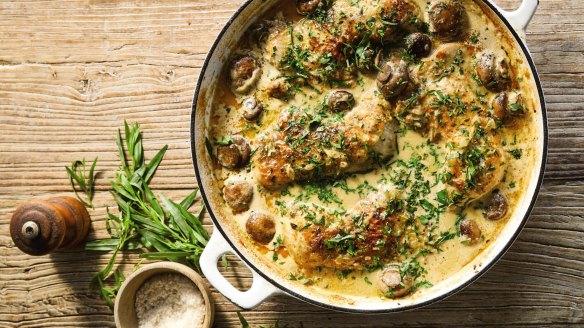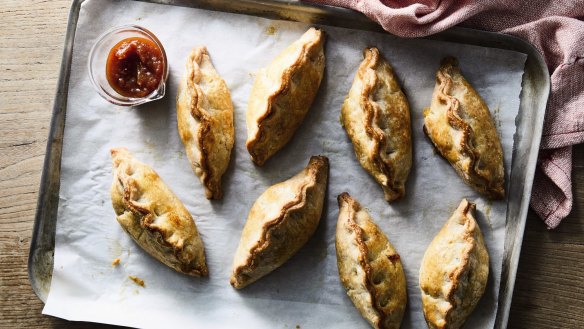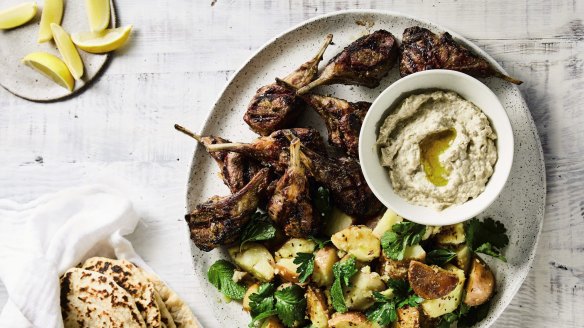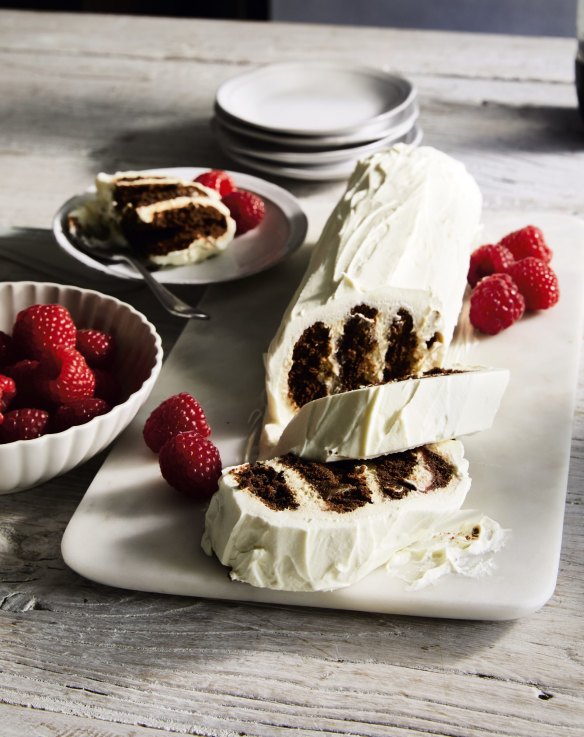Home-spun secrets: Four recipes from Stephanie Alexander's new cookbook

Updated , first published

Stephanie Alexander's newest cookbook ticks every feed-the-family box. Nothing too fancy, just thoughtful combinations to share and bring joy to the table.
Chicken marylands with mushrooms and tarragon in a cream sauce

This combination – chicken, mushrooms, tarragon, cream – is a classic in the French regional repertoire. It may seem dangerous with the inclusion of both butter and cream but they are used in modest quantities and add lusciousness. I have suggested using chicken marylands. You might prefer to buy thighs, purchased with the bone in and the skin on. This dish is not suitable for breast portions as it needs to cook for quite a long time to develop the best flavour. The more muscular sections respond well to longer cooking. I like to serve this with a vegetable puree or maybe firm or soft polenta. Mashed potato is always a winner. Do not omit the final garnish of freshly chopped French tarragon. Its perfume brilliantly reinforces the flavour of the tarragon in the sauce.
INGREDIENTS
- 4 free-range chicken marylands, skin on or 8 large chicken thighs, bone in, skin on
- 2 tbsp plain flour
- 1 tsp sea salt
- 1 tsp sweet paprika
- 1 tbsp chopped French tarragon
- 2 tbsp ghee or clarified butter
- 1 onion, finely chopped
- 3 garlic cloves, finely chopped
- 100ml tarragon vinegar or verjuice
- 200ml golden chicken stock (see recipe below)
- 20g unsalted butter
- 250g Swiss brown button mushrooms, halved if not small
- freshly ground black pepper
- 150ml cream
Garnish
- 2 tsp coarsely chopped flat-leaf parsley
- 1 tbsp coarsely chopped French tarragon
METHOD
- Preheat the oven to 160C fan-forced (180C conventional). If using chicken marylands, I chop off the knobby end of the leg bone to save space in my casserole. Mix the flour, salt, paprika and tarragon in a bowl and thoroughly coat each piece of chicken with this mixture. Shake each piece of floured chicken well and transfer to a tray.
- Select a heavy-based flameproof casserole that will hold all the chicken in one layer and that has a lid. Heat the ghee or clarified butter in it over medium heat. When it has just started to sizzle put the chicken pieces into the pan skin-side down and adjust the heat so that there is a sizzle but nothing more than that. You are aiming for well-browned pieces. Do not shake or prod. Check after 6 minutes. If the skin is looking golden brown, turn the chicken and cook for a further 3-4 minutes. Now remove the chicken pieces to the tray or a plate.
- Add the onion and garlic to the pan, stirring to mix, then lower the heat and cook for a full 5 minutes, stirring once or twice. The onion must be very soft. Raise the heat to high and tip in the tarragon vinegar or verjuice. Let it bubble up and almost entirely evaporate. Then add the stock and bring the pan back to a simmer. Stir and simmer for a few minutes, then return the chicken pieces to the pan. Press a crumpled piece of baking paper down over the chicken (this helps retain moisture) and put on the lid. Transfer the casserole to the oven for 45 minutes if using thighs only or 55 minutes to 1 hour if using marylands. Remove the casserole from the oven and test that the chicken pieces are tender. A skewer should slip through the thickest part of the chicken without resistance.
- While the chicken is cooking heat the butter over medium heat in a heavy-based frying pan that has a lid and tip in the mushrooms. Toss to coat with the butter, then grind on some pepper, cover and cook over medium heat for 4 minutes. Uncover and pour in the cream, then raise the heat to high and bring to a boil, stirring once or twice. The cream should bubble up and start to reduce. Turn off the heat and set the pan aside.
- Tip the mushroom and cream sauce onto the chicken once it tests tender, then give the casserole a shake and a stir to mix. Place the casserole over medium heat for about 5 minutes to reduce the sauce further. The aim is for a rich, creamy, not-too-liquid sauce. Taste for salt and pepper and adjust if necessary. Scatter half of the garnish over the chicken. Serve on warmed plates, scattering each portion with the remaining herbs.
Prepare ahead The dish (excluding the mushroom and cream sauce) can be prepared several hours or even a day ahead and refrigerated. Bring the chicken casserole back to bubbling in the oven at 160C fan-forced (180C conventional) for maybe 30 minutes. Make the mushroom and cream sauce while the chicken is reheating. Transfer the casserole to the stovetop and add the sauce. Reduce the sauce and add the garnish as described.
Serves 4
Golden chicken stock
This is a recipe for a good chicken stock suitable for when you have bought chicken carcasses and have all the ingredients to hand. Many times I have made do with a lesser stock made from a cooked carcass, a few poultry bones and scraps that I had frozen, and whatever appropriate vegetables were in the refrigerator and herbs in the garden. In other words, make stock with what you have. I do find that at any good seller of poultry a request for carcasses and necks is usually happily obliged.
Cleaned gizzards are often sold at poultry stores and a few can enrich your stock. They are a muscular part of the hen's stomach and must be opened and cleaned of the gritty contents before being used. It is worth noting that "giblets" is a collective noun that correctly includes all the edible internal organs of a bird: the liver and the heart as well as the gizzard. It is frequently incorrectly used to mean the gizzard specifically.
If you lightly oil the bones and vegetables and roast them in a moderate oven for half an hour you will have a more deeply coloured stock. It will not necessarily have better flavour. Reducing any stock concentrates its flavour. Reduction is so often a cook's best friend!
It is important that a just-cooked stock cools as rapidly as possible. It is not good or safe practice to put a pot of hot stock in the refrigerator and hope for the best. Much better to divide the stock between two or three smaller bowls, and allow them to cool a little before refrigerating. At that point the contents of each could be safely combined.
INGREDIENTS
- 2 chicken carcasses, chopped
- 500g chicken wings or necks
- a few cleaned chicken gizzards, if available
- 1 onion, unpeeled and thickly sliced
- 1 large carrot, peeled and sliced
- 1 leek, washed well and sliced
- 1 celery stalk, sliced
- 6 flat mushrooms, chopped
- 3-4 garlic cloves, unpeeled and bruised
- 1 bay leaf
- 1 large thyme sprig
- a few parsley stalks
METHOD
- Put the carcasses, wings or necks, and gizzards, if using, into a stock pot and cover generously with cold water. Bring to simmering point over medium heat and skim well. Add everything else. Adjust the heat to maintain a gentle simmer and simmer for 4-5 hours. Strain the stock and allow to cool (see my comments above for the best way to do this) before refrigerating until cold.
- Remove any fat that has risen to the top. Return the stock to a clean saucepan and reduce by one-third to concentrate the flavour, then cool again. Refrigerate the stock for 2-3 days or ladle it into smaller containers, then label, date and freeze.
Makes about 2 litres

Cheese and vegetable pasties or a larger family galette
Resourcing the Stephanie Alexander Kitchen Garden program has always been a challenge. So it is a good moment to thank all of those who have volunteered to help in our schools and early-learning centres. We could not have got this far without your help.
I was therefore delighted to read the headnote in a recipe for a free-form potato and cheese pie in Mr & Mrs Wilkinson's How it is at Home that the clever chef and Kitchen Garden volunteer Matt Wilkinson had helped teach year 3 students at Westgarth Primary School to make a very similar pie to the one I include here.
Because several of the ingredients here are sauteed or cooked separately, this pie is a great one to prepare with young helpers. Depending on their age or skill level, they can peel, chop or saute (peeling the pumpkin will need supervision and possibly a bit of help).
You can vary the filling as you wish. Sometimes I use sweet potato in place of the pumpkin, and I often include some chopped silverbeet leaves. The small pies are great for school lunches or a picnic. They are just as good hot or cold.
INGREDIENTS
- 1 quantity lard pastry (see recipe below)
- 250g waxy potatoes, peeled and cut into 1cm cubes
- ⅓ cup freshly shelled peas or broad beans
- 250g piece pumpkin, peeled and cut into 1cm cubes
- 1 tbsp extra-virgin olive oil
- 1 small onion or 2 shallots, finely sliced
- 1 garlic clove, finely sliced
- 100g cheddar, freshly grated
- sea salt and freshly ground black pepper
- plain flour, for dusting
- 100g hummus
- 1 free-range egg
METHOD
- Make the pastry as instructed and refrigerate it for 30 minutes. It will be easy to roll after this time.
- Meanwhile, preheat the oven to 180C fan-forced (200C conventional). Put the potato into a saucepan of cold water and bring to a boil over medium heat. Simmer for 5 minutes, then drop in the peas or beans. Cook for a further 4 to 5 minutes, then drain well and tip into a large bowl.
- Toss the pumpkin cubes with half the olive oil in a baking tray and roast for 10 minutes. Add to the bowl with the potato. Saute the onion or shallot and garlic in a small frying pan with the rest of the olive oil over medium heat until quite limp and starting to colour. Add to the bowl.
- If you are making the small or medium pasties it is a good idea to tip the contents of the bowl into a food processor now and pulse the mixture for a few seconds. This ensures that the pieces are not too chunky for the pastry. Return the mixture to the bowl and add the cheese, then season with salt and pepper.
- Dust your workbench and rolling pin with a little flour. To make small or medium pasties, roll out the pastry and cut out twelve 6cm or eight 10cm rounds. Place about a teaspoon of hummus in the centre of each pastry round and spread lightly with the back of a teaspoon. Place a heaped spoonful of filling on each round. Whisk the egg lightly with a pinch of salt. Brush the edges with this egg wash and seal the pasties well. Make a small slit in the top of each pasty with sharp knife to allow the steam to escape. Line a baking tray with baking paper and transfer the pasties to it.
- To make a large family galette, line a baking tray with baking paper. Roll and cut a 26cm pastry round and transfer it to the baking tray. Spread the pastry with hummus, leaving a 4cm border, and top with an even layer of the vegetable mixture. Fold the edge over the filling, pleating it as you go. Whisk the egg lightly with a pinch of salt. Brush the pastry with this egg wash.
- Bake small or medium pasties at 180C fan-forced (200C conventional) for 20 minutes. To bake a large family galette, increase the oven temperature to 200C fan-forced (220C conventional) and bake for 30 minutes.
Makes 16 small, 12 medium or 1 large
Lard pastry
INGREDIENTS
- 150g self-raising flour
- 150g plain flour
- pinch of sea salt
- 150g lard, at room temperature
- ½ cup ice-cold water
METHOD
- Tip the flours and salt into the bowl of a food processor and process for a few seconds. Now add the lard and pulse for three or four bursts. Stop and check that the mixture is looking like coarse breadcrumbs. Now add the cold water and give another three or four bursts until the pastry forms a soft ball. Transfer the pastry to a floured surface, work it quickly into a ball, then flatten it and wrap. Chill for 30 minutes before rolling, as required by your recipe.

Speedy and spicy lamb cutlets with hot potato salad and baba ghanoush
Like many Australians I love our sweet lamb, and I especially love well-trimmed lamb cutlets. Often I ask my butcher to cut double lamb cutlets. The extra thickness ensures that you can grill each double cutlet quite hard for a crusty exterior but the middle of each will still be pink. Double cutlets cooked in this manner will benefit from a few minutes' rest – which will happen without any fuss if you serve a platter of them to the centre of the table. If you double the size of the cutlets, you will also need to double the amount of marinade. In the marinade I use sambal oelek, originally an Indonesian spice mixture that typically includes garlic, ginger and lemongrass as well as plenty of hot chillies and a little sugar.I keep a small jar of this in my refrigerator ready to add a chilli note whenever. It stays fresh for months.
INGREDIENTS
- 12 trimmed lamb cutlets
- 1 quantity yoghurt flatbread dough (see recipe below)
- 1 lemon, cut into wedges
Baba ghanoush
- 1 large eggplant
- 1 garlic clove, crushed
- sea salt juice of 1 lemon
- ⅓ cup tahini
- 2 tbsp water
- 2-3 tbsp thick Greek-style yoghurt
- freshly ground black pepper
Marinade
- 1 tbsp finely grated ginger
- 2 garlic cloves, finely chopped
- 1 long green chilli, seeded and finely chopped
- ½ tsp sambal oelek
- 1 tsp sea salt
- 1 tbsp vegetable oil
Hot potato salad
- 2 tbsp vegetable oil
- ½ tsp mustard seeds
- ½ tsp cumin seeds
- 8 waxy potatoes, unpeeled and cut into bite-sized chunks
- tiny pinch of ground turmeric
- sea salt
- 1 handful mint leaves
- 1 handful coriander leaves
- 1 handful coarsely chopped flat-leaf parsley
- freshly ground black pepper
METHOD
- To make the baba ghanoush, place the eggplant on the barbecue grill over medium heat, or settle the eggplant on a rack over a moderate gas flame if cooking indoors. Every few minutes turn the eggplant using tongs. Be gentle. You do not want to split the skin. The flesh will be quite soft after 10-15 minutes. Lift the charred eggplant onto a plate and allow it to cool a bit. Then strip away the black skin carefully, using a small knife and possibly your fingers, trying not to waste any of the flesh. The flesh is meant to be a bit discoloured (this is where the smoky flavour comes from) so do not discard any that looks bronze or even blackish. Resist the idea of rinsing the eggplant under a tap as you will reduce the flavour. Once peeled, split the eggplant open and remove and discard any really seedy sections with a sharp teaspoon. Now put the flesh into a colander or non-reactive strainer resting over a bowl and let it drain for about 30 minutes.
- Chop the drained flesh roughly and transfer to a bowl. Mix the crushed garlic to a paste with a pinch of salt and stir into the eggplant with the lemon juice. Season to taste. Mix the eggplant puree and tahini in a small bowl – the mixture will "tighten". Loosen the mixture with the water, and stir in the yoghurt. Taste and season with salt and pepper. Set aside until needed.
- Combine all the ingredients for the lamb marinade in the small bowl of a food processor and process to a paste. Rub the marinade all over the cutlets and leave at room temperature for 1 hour.
- While the cutlets are marinating, make the flatbreads and the potato salad.
- Prepare the flatbread dough as instructed, and set it aside to prove for 30 minutes.
- While the dough is proving, preheat the oven to 80C fan-forced (100C conventional) with a baking dish in it.
- Meanwhile, make the hot potato salad. Heat the vegetable oil in a wok or a deep frying pan over high heat and add the mustard seeds and cumin seeds. Stir for a few seconds with a wooden spoon, then add the potato and turmeric and season with salt. Cover and cook over medium heat for about 15 minutes, stirring several times. Add a splash of water to the potato if the chunks are sticking. Ideally they will brown and maybe break up a bit.
- While the potato is frying, divide the flatbread dough into eight balls. With well-floured hands and a floured rolling pin, gently roll each ball until 2mm thick. Cook the flatbread in a dry heavy-based frying pan or on the preheated flat plate of your barbecue for 2 minutes each side. The flatbreads will lift and bubble and will develop charred grill marks here and there. Slip the flatbreads as they are made into a folded clean tea towel and transfer to the low oven to keep warm.
- When the potatoes are nearly cooked, heat an overhead griller or a chargrill pan to medium-high and cook the lamb cutlets for about 3 minutes each side. Toss the fresh herbs through the hot potato, then grind on some pepper and tip the hot salad onto a large serving dish. Add the lamb cutlets, and serve the baba ghanoush and flatbreads on the side. Offer lemon wedges to squeeze over the lamb.
Serves 4 (easily doubled)
Yoghurt flatbread
These very simple flatbreads are ideal to serve with a selection of dips, or alongside a curry or indeed any dish that has juices that are too good to waste. Or they can hold small meatballs and a chutney. After the initial resting and shaping the balls of dough can be refrigerated, covered, and rolled and cooked any time in the next couple of hours.
INGREDIENTS
- 150g wholemeal plain flour
- 150g plain flour
- 1 tsp sea salt
- 2 tsp instant dried yeast
- 1 tsp baking powder
- 150ml Greek-style yoghurt
- ½ cup warm water
- 2 tbsp extra-virgin olive oil
METHOD
- Put the flours, salt, yeast and baking powder into a bowl and give a whisk to mix. Mix the yoghurt, water and olive oil in another bowl. Make a well in the dry ingredients, then tip in the liquids and mix with a wooden spoon to form a sticky dough. Scrape the dough onto a well-floured workbench and knead gently until smooth. Place in a lightly oiled bowl, then cover with a dry tea towel and leave to relax and prove for 30 minutes.
- Heat a very heavy-based frying pan or the flat plate of a barbecue to high. If you are using a frying pan, preheat the oven to 80C fan-forced (100C conventional) with a baking tray lined with a clean, dry tea towel inside the oven (you will only be able to cook 1 to 2 flatbreads at a time in the pan, and they need to kept warm while you cook the next batch). If you are using the barbecue plate, have a basket or plate lined with a tea towel at the ready.
- Divide the dough into eight balls. With well-floured hands and a floured rolling pin, gently roll each ball out until 2mm thick. Grill or dry-fry for 2 minutes each side. The flatbreads will lift and bubble and develop charred marks here and there. If you are using the frying pan, lift the flatbreads from the pan and slip them into the folded tea towel in the oven to keep warm and tender while you cook the next batch. If you've cooked the flatbreads on the barbecue plate, slip them into the tea towel and take to the table. Serve immediately.
Makes 8

Chocolate ripple, espresso, rum and raspberry log
A blast from the past. I had not eaten or even seen a chocolate ripple cake since my teenage years. But at my brother's party for his 70th birthday his charming neighbour Carina volunteered to make a collection of sweet dishes. She did a wonderful job. Several pavlovas, each with a different topping, an inspiring trifle, and a chocolate ripple cake served on a long, narrow platter that had belonged to my mother and that I had not seen for more than 50 years but instantly remembered from childhood. I have slightly modified the recipe.
If you like to see zebra stripes when you cut the cake, be generous with the cream. If, like me, you prefer the cream to be soaked into the biscuits, use less to sandwich them but be generous with the final layer.
INGREDIENTS
- 1½ cups thickened cream
- 225g mascarpone, kept cold until needed
- 2 tbsp cold strong espresso coffee
- 1 tbsp rum (optional)
- ⅓ cup best-quality raspberry jam
- 1 packet Choc Ripple biscuits
- raspberries or strawberries, to serve
METHOD
- Select a narrow plate on which to build your ripple cake. Whip the cream to firm peaks. Separately scoop the mascarpone into a small bowl and work with a spatula until smooth. Mascarpone becomes grainy when it gets too warm, so only remove it from the refrigerator to the bowl once the cream has been whipped. Fold the mascarpone into the whipped cream.
- Mix the coffee with the rum, if using.
- Assemble your ingredients and utensils: a pastry brush, the bowl with the rum and coffee, the jam in a bowl with its own spoon, the bowl of the cream mixture and a separate spoon, a long flexible metal spatula, and the biscuits. Spoon a thin layer of the cream mixture down the centre of the serving plate – this is where you will plant your dressed biscuits.
- Take your first biscuit. Very lightly brush the flat side with the coffee/rum mixture and follow with a small blob of jam. Plant this biscuit standing upright at one end of the cream on the plate, ripple side to the outside and the flat side ready for the next biscuit. Take another biscuit. Very lightly brush the flat side with the coffee/ rum mixture and a small blob of jam, but this time spread a dollop of cream on the ripple side. Place the cream side against the first biscuit and gently press. Repeat this last step with the remaining biscuits: coffee/rum mixture and jam on the flat side, cream on the ripple side, then plant. Don't use all the cream – you need enough left to coat the log just before serving. When you have finished the log, use the spatula to neaten the cream that will have oozed from between the biscuits. This is good. Using some of the cream that remains spread a thin layer over the sides and ends of the log, leaving enough for a final coat after its overnight rest.
- Insert a few toothpicks into the log and cover with plastic film – the toothpicks will hold the plastic away from the cream. Refrigerate the log and the remaining mascarpone cream overnight.
- To serve, unwrap the log and apply a fresh coating of mascarpone cream. Surround the log with berries and slice to serve.
Serves 8
This is an edited extract from Home by Stephanie Alexander, published by Macmillan Australia, photography by Armelle Habib, RRP $59.99. Buy now
Appears in these collections
From our partners
Original URL: https://www.smh.com.au/goodfood/homespun-secrets-four-recipes-from-stephanie-alexanders-new-cookbook-20210831-h1yaar.html